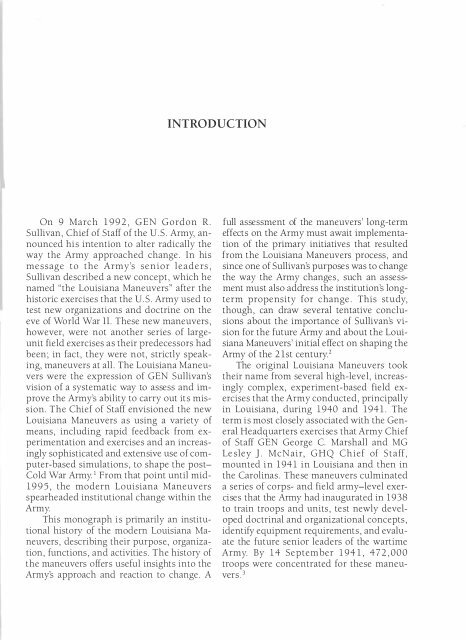The Modern Louisiana Maneuvers - US Army Center Of Military History
The Modern Louisiana Maneuvers - US Army Center Of Military History
The Modern Louisiana Maneuvers - US Army Center Of Military History
You also want an ePaper? Increase the reach of your titles
YUMPU automatically turns print PDFs into web optimized ePapers that Google loves.
On 9 March 1992, GEN Gordon R.<br />
Sullivan, Chief of Staff of the u.S. <strong>Army</strong>, announced<br />
his intention to alter radically the<br />
way the <strong>Army</strong> approached change. In his<br />
message to the <strong>Army</strong>'s senior leaders,<br />
Sullivan described a new concept, which he<br />
named "the <strong>Louisiana</strong> <strong>Maneuvers</strong>" after the<br />
historic exercises that the u.S. <strong>Army</strong> used to<br />
test new organizations and doctrine on the<br />
eve of Wo rld War II. <strong>The</strong>se new maneuvers ,<br />
however, were not another series of largeunit<br />
field exercises as their predecessors had<br />
been; in fact, they were not, strictly speaking,<br />
maneuvers at all. <strong>The</strong> <strong>Louisiana</strong> <strong>Maneuvers</strong><br />
were the expression of GEN Sullivan's<br />
vision of a systematic way to assess and improve<br />
the <strong>Army</strong>'s ability to carry out its mission.<br />
<strong>The</strong> Chief of Staff envisioned the new<br />
<strong>Louisiana</strong> <strong>Maneuvers</strong> as using a variety of<br />
means, including rapid feedback from experimentation<br />
and exercises and an increasingly<br />
sophisticated and extensive use of computer-based<br />
simulations, to shape the post<br />
Cold War <strong>Army</strong> 1 From that point until mid-<br />
1995, the modern <strong>Louisiana</strong> <strong>Maneuvers</strong><br />
spearheaded institutional change within the<br />
<strong>Army</strong><br />
This monograph is primarily an institutional<br />
history of the modern <strong>Louisiana</strong> <strong>Maneuvers</strong><br />
, describing their purpose, organization,<br />
functions , and activities. <strong>The</strong> history of<br />
the maneuvers offers useful inSights into the<br />
<strong>Army</strong>'s approach and reaction to change. A<br />
INTRODUCTION<br />
full assessment of the maneuvers' long-term<br />
effects on the <strong>Army</strong> must await implementation<br />
of the primary initiatives that resulted<br />
from the <strong>Louisiana</strong> <strong>Maneuvers</strong> process , and<br />
since one of Sullivan's purposes was to change<br />
the way the <strong>Army</strong> changes , such an assessment<br />
must also address the institution's longterm<br />
propensity for change. This study,<br />
though, can draw several tentative conclusions<br />
about the importance of Sullivan's vision<br />
for the future <strong>Army</strong> and about the <strong>Louisiana</strong><br />
<strong>Maneuvers</strong>' initial effect on shaping the<br />
<strong>Army</strong> of the 21st century2<br />
<strong>The</strong> original <strong>Louisiana</strong> <strong>Maneuvers</strong> took<br />
their name from several high-level, increasingly<br />
complex, experiment-based field exercises<br />
that the <strong>Army</strong> conducted, principally<br />
in <strong>Louisiana</strong>, during 1940 and 1941. <strong>The</strong><br />
term is most closely associated with the General<br />
Headquarters exercises that <strong>Army</strong> Chief<br />
of Staff GEN George C. Marshall and MG<br />
Lesley ]. McNair, GHQ Chief of Staff,<br />
mounted in 1941 in <strong>Louisiana</strong> and then in<br />
the Carolinas . <strong>The</strong>se maneuvers culminated<br />
a series of corps- and field army-level exercises<br />
that the <strong>Army</strong> had inaugurated in 1938<br />
to train troops and units , test newly developed<br />
doctrinal and organizational concepts,<br />
identify equipment requirements, and evaluate<br />
the future senior leaders of the wartime<br />
<strong>Army</strong> By 14 September 1941, 472,000<br />
troops were concentrated for these maneuvers<br />
3
















